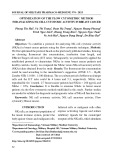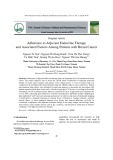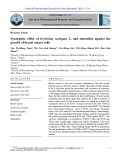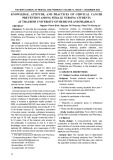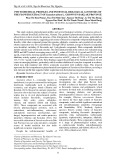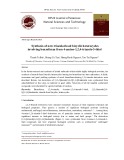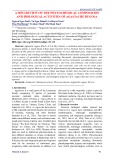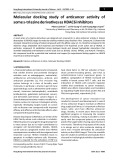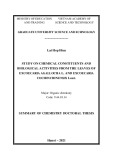doi:10.1046/j.1432-1033.2002.02938.x
Eur. J. Biochem. 269, 2698–2707 (2002) (cid:1) FEBS 2002
Group IID heparin-binding secretory phospholipase A2 is expressed in human colon carcinoma cells and human mast cells and up-regulated in mouse inflammatory tissues
Makoto Murakami1, Kumiko Yoshihara1, Satoko Shimbara1, Masatsugu Sawada2, Naoki Inagaki2, Hiroichi Nagai2, Mikihiko Naito3, Takashi Tsuruo3, Tae Churl Moon4, Hyeun Wook Chang4 and Ichiro Kudo1 1Department of Health Chemistry, School of Pharmaceutical Sciences, Showa University, Tokyo; 2Pharmacological Department, Gifu College of Pharmacy, Gifu, Japan; 3Institute of Molecular and Cellular Biosciences, University of Tokyo, Tokyo, Japan; 4College of Pharmacy, Yeungnam University, Gyonsan, Korea
preference for A23187-primed membranes. Several human colon carcinoma cell lines expressed sPLA2-IID and sPLA2- X constitutively, the former of which was negatively regu- lated by IL-1. sPLA2-IID, but not other sPLA2 isozymes, was expressed in human cord blood-derived mast cells. The expression of sPLA2-IID was significantly altered in several tissues of mice with experimental inflammation. These results indicate that sPLA2-IID may be involved in inflam- mation in cell- and tissue-specific manners under particular conditions.
Keywords: phospholipase A2; colon carcinoma; mast cell;
Group IID secretory phospholipase A2 (sPLA2-IID), a heparin-binding sPLA2 that is closely related to sPLA2-IIA, augments stimulus-induced cellular arachidonate release in a manner similar to sPLA2-IIA. Here we identified the resi- dues of sPLA2-IID that are responsible for heparanoid binding, are and therefore essential for cellular function. Mutating four cationic residues in the C-terminal portion of sPLA2-IID resulted in abolition of its ability to associate with cell surface heparan sulfate and to enhance stimulus- induced delayed arachidonate release, cyclooxygenase-2 induction, and prostaglandin generation in 293 cell trans- fectants. As compared with several other group II subfamily sPLA2s, which were equally active on A23187- and IL-1- primed cellular membranes, sPLA2-IID showed apparent
Phospholipase A2 (PLA2), which catalyzes the hydrolysis of the ester bond of the sn-2 position of glycerophospholipid to liberate free fatty acid and lysophospholipid, is structurally and functionally subdivided into four major classes: secre- tory PLA2 (sPLA2), cytosolic PLA2 (cPLA2), Ca2+-inde- pendent PLA2 (iPLA2) and platelet-activating factor acetylhydrolase [1]. The sPLA2 family comprises Ca2+- dependent, disulfide-rich and low molecular mass (14–18 kDa) enzymes with histidine residue in the catalytic center. To date, 10 sPLA2 isozymes (IB, IIA, IIC, IID, IIE, IIF, III, V, X, and XII) have been identified in mammals [1,2]. A subset of sPLA2s contributes to the release of arachidonic acid for eicosanoid generation and can also participate in a variety of physiological events.
The regulatory functions of sPLA2-IIA, a prototypic proinflammatory sPLA2, have been investigated in a number of studies [3–18]. In general, this enzyme is exocytosed or newly synthesized and secreted by the cells after stimulation with proinflammatory agents [3–6] and plays an augmentative role in arachidonic acid release and prostaglandin generation [4–12], elimination of infectious bacteria [13–15], and other pathophysiological events [16–18]. Subsequently, several new group II subfamily sPLA2s (IIC, IID, IIE, IIF, and V), the genes for which are clustered in the same chromosome locus, have been identified [19–24]. Among them, sPLA2-V has the ability to augment cellular arachidonic acid release often more efficiently than does sPLA2-IIA [8–12,25,26], whereas the functions of the other novel group II sPLA2s are obscure. sPLA2-IB (pancreatic PLA2) and -X, the genes for which each map to distinct chromosomes, have a unique N-terminal prepropeptide and proteolytic removal of this prepropeptide produces an active enzyme [27–29]. sPLA2- IB plays a role in the digestion of dietary phospholipids in the gastrointestinal tract and stimulates cellular responses by acting as a ligand for the sPLA2 receptor [30,31]. sPLA2-X potently promotes arachidonic acid release through acting on the external plasma membrane of target cells, an event depending on its interfacial binding to zwitterionic phos- phatidylcholine [11,12,29,32,33].
Accumulating evidence has suggested that the cellular functions of the heparin-binding group II subfamily of sPLA2s (IIA and V) are influenced both positively [7–12] and negatively [34,35] by heparan sulfate proteoglycan
Correspondence to M. Murakami, the Department of Health Chemistry, School of Pharmaceutical Sciences, Showa University, 1-5-8 Hatanodai, Shinagawa-ku, Tokyo 142-8555, Japan. Fax: + 81 3 3784 8245, Tel.: + 81 3 3784 8197, E-mail: mako@pharm.showa-u.ac.jp Abbreviations: sPLA2, secretory phospholipase A2; cPLA2, cytosolic phospholipase A2; COX, cyclooxygemase; mPGES, microsomal PGE2 synthase; cPGES, cytosolic PGE2 synthase; HSPG, heparan sulfate proteoglycan; IL, interleukin; SCF, stem cell factor; LPS, lipopolysaccharide; DNFB, 2,4-dinitroflurobenzene; GAPDH, glyceraldehyde-3-phosphate dehydrogenase. Enzyme: phospholipase A2 (EC 3.1.1.4). (Received 28 January 2002, revised 15 April 2002, accepted 17 April 2002)
Analyses of group IID phospholipase A2 (Eur. J. Biochem. 269) 2699
(cid:1) FEBS 2002
The enzyme immunoassay kit for PGE2 was from Cayman Chemicals (Ann Arbor, MI, USA). Rabbit antihuman COX-1 and antihuman cPLA2a antibodies were from Santa Cruz. Anti-human cytosolic PGE2 synthase (cPGES) antibody was prepared as described previously [39]. Lipofectamine PLUS reagent, Opti-MEM medium, geneticin and TRIzol reagent were from Life Technologies. Horseradish peroxidase-conjugated antigoat and antirabbit IgGs were from Zymed. A23187 was from CalBiochem. Human IL-1b was obtained from Genzyme.
Construction of sPLA2-IID mutants
(HSPG) on cell surfaces. In the former situation, the glycosylphosphatidylinositol-anchored HSPG glypican supports the arachidonic acid-releasing function of the HSPG-binding sPLA2s by sorting them into particular caveolin-rich punctate and perinuclear compartments [10,12]. Conversely, certain HSPG moieties facilitate inter- nalization and subsequent proteolytic degradation, thereby leading to inactivation of the HSPG-binding sPLA2s [34,35]. Thus, in addition to their enzymatic characteristics, the HSPG-binding properties of sPLA2s also dictate their cellular behaviors and functions. Cationic amino acid clusters in the N- and/or C-terminal domains of sPLA2- IIA [7,36] and sPLA2-V [8,34] are responsible for their functional association with HSPGs.
sPLA2-IID, an isozyme most related to sPLA2-IIA, is reportedly expressed in immune and digestive organs and is proposed to replace sPLA2-IIA under certain conditions [21,22]. We have recently shown that sPLA2-IID, like sPLA2-IIA, binds to the HSPG glypican and augments the arachidonic acid-releasing response in HEK293 cells [12]. To better understand the regulatory functions of sPLA2- IID, we have determined its functional HSPG-binding site by site-directed mutagenesis. Furthermore, we show that this isozyme is expressed in human colon carcinoma cell lines and human mast cells as well as various mouse tissues. Importantly, the expression of sPLA2-IID is regulated both positively and negatively by proinflammatory stimuli.
Mouse sPLA2-IID mutants were produced by PCR with the Advantage cDNA polymerase mix (Clontech). The condi- tion of PCR was 25 cycles at 94 (cid:2)C, 55 (cid:2)C and 72 (cid:2)C for 30 s each. The primers used were as follows: mIID-5¢, 5¢-AT GAGACTCGCCCTGCTGTGTG-3¢; KE2, 5¢-TTAGCA TGCTGGAGTCTCGCCTTCGCAAC-3¢; and KE2RS2, 5¢-GCATGCTGGAGTCTCGCCTTCGCAACAGGGCC ACCAGTA-3¢. PCR was preformed with mIID-5¢ and KE2 or KE2RS2 using mouse sPLA2-IID cDNA as a template. Each PCR product was ligated into pCR3.1 (Invitrogen) and was transfected into Top10F¢ supercom- petent cells (Invitrogen). The plasmids were isolated and sequenced using a Taq cycle sequencing kit (Takara, Ohtsu, Japan) and an autofluorometric DNA sequencer DSQ-1000 L (Shimadzu, Tokyo, Japan) to confirm the sequences.
M A T E R I A L S A N D M E T H O D S
RT-PCR and Southern blotting
Materials
1
HEK293 cells (Human Science Research Resources Bank, Osaka, Japan) and colon carcinoma cell lines (American Type Culture Collection) were cultured in RPMI 1640 medium (Nissui Pharmaceutical Co., Tokyo, Japan) con- taining 10% fetal bovine serum [8–12]. cDNAs for human and mouse sPLA2s, human cyclooxygenase (COX)-2 and human microsomal prostaglandin E2 (PGE2) synthase (mPGES) and their HEK293 cell transfectants were described previously [8–12,37].
2
To obtain human cord blood-derived mast cells [38], heparin-treated umbilical cord blood was obtained from normal full-term vaginal deliveries under auspices of the Kyungpook National University Hospital. Cord blood was diluted with the same volume of NaCl/Pi and layered over Histopaque-1077 (Sigma) at room temperature within 4 h of delivery. The cord blood monoculcear cell fraction was obtained after centrifugation at 1000 g for 20 min at room temperature. The cells were washed twice with NaCl/Pi and grown in tissue culture flasks in AIM-V medium (Life Technologies) in the presence of 100 ngÆmL)1 recombinant human stem cell factor (SCF) for 8 weeks. Non-adherent cells were then cultured for an additional 2 weeks with 100 ngÆmL)1 SCF and 50 ngÆmL)1 human interleukin (IL)- 6 in AIM-V medium. The mast cells thus obtained were > 97% tryptase- and (cid:1) 70% chymase-positive as demon- strated by immunocytostaining using specific antibodies, expressed functional c-kit and Fce receptor I as assessed by flow cytometry, and responded to immunological and nonimmunological stimuli to secrete granule contents (T. C. Moon, M. Murakami, I. Kudo & H. W. Chang, unpub- . lished data)
Synthesis of cDNAs was performed using avian myeloblas- tosis virus reverse transcriptase and 0.5 lg total RNA from mouse tissues and human cell lines, according to the manufacturer’s instructions supplied with the RNA PCR the cDNA kit (Takara). Subsequent amplification of fragments was performed using 1 lL of the reverse- transcribed mixture as a template with specific oligonucle- otide primers (Greiner Japan) as follows: mIID-5¢ and mIID-3¢ (see above); human cPLA2a sense, 5¢-ATGTCATT TATAGATCCTTACC-3¢ and antisense, 5¢-TCAAAGTT CAAGAGACATTTCAG-3¢; human mPGES sense, 5¢-AT GCACTTCCTGGTCTTCCTCG-3¢ and antisense, 5¢-GC TTCCCCAGGAAGGCCACGG-3¢; human sPLA2-IB sense, 5¢-ATGAAACTCCTTGTGCTAGCTG-3¢ and anti- sense, 5¢-TCAACTCTGACAATACTTCTTGG-3¢; human sPLA2-hIIA sense, 5¢-CAGAATGATCAAGTTGACGAC AG-3¢ and antisense, 5¢-TCAGCAACGAGGGGTGCTC CTC-3¢; human sPLA2-hIID sense, 5¢-ATGGAACTTGCA CTGCTGTGTG-3¢ and antisense, 5¢-CAGTCGCTTCTG GTAGGTGTCC-3¢; human sPLA2-IIE sense, 5¢-ATGAA ATCTCCCCACGTGCTGG-3¢ and antisense, 5¢-TGTAG GTGCCCAGGTTGCGGCG-3¢; human sPLA2-IIF sense, 5¢-ATGAAGAAGTTCTTCACCGTG-3¢ and antisense, 5¢-CTAGCAGGTGACCTCCTCAGG-3¢; human sPLA2- V sense, 5¢-ATGAAAGGCCTCCTCCCACTGG-3¢ and antisense, 5¢-GGCCTAGGAGCAGAGGATGTTG-3¢; and human sPLA2-X sense, 5¢-ATGCTGCTCCTGCTAC TGCCG-3¢ and antisense, 5¢-TCAGTCACACTTGGGC GAGTC-3¢. PCR conditions were 94 (cid:2)C for 30 s and then 30 cycles of amplification at 94 (cid:2)C for 5 s and 68 (cid:2)C for 4 min, using the Advantage cDNA polymerase mix. RT-PCR of glyceraldehyde-3-phosphate dehydrogenase
2700 M. Murakami et al. (Eur. J. Biochem. 269)
(cid:1) FEBS 2002
(GAPDH) was performed using specific primers (Clontech). The PCR products were analyzed by 1% agarose gel electrophoresis with ethidium bromide staining. The gels were further subjected to Southern blot hybridization using appropriate cDNAs as probes.
3
Lipopolysaccharide treatment of mice Lipopolysaccharide (LPS) (5 mgÆkg)1) was administered intraperitoneally to 4-week-old male C57BL/6 mice (Nip- pon Bio-Supply Center, Tokyo, Japan). After 24 h, mice were sacrificed by bleeding, their organs were removed, and RNA was extracted by homogenization in TRIzol reagent using 10 strokes of a Potter homogenizer at 1000 r.p.m.
Mouse ear atopic dermatitis
to the ears of mice result
Five repeated topical applications of 2,4-dinitrofluoroben- zene (DNFB) in contact hypersensitivity of the ears as well as significant elevation of serum IgE levels, accompanied by the increased TH1 response for the onset of skin dermatitis and the TH2 response in the lymph node [40]. The ears of C57BL/6 mice (Nippon Bio-Supply Center) were painted with 25 lL 0.15% (w/v) DNFB or vehicle (acetone/olive oil 3 : 1) once a week. The ears were removed 24 h after the fifth painting and subjected to RNA extraction. Replicate ear sections were fixed by formalin, embedded in paraffin and stained with hematoxylin and eosin to verify the progress of inflammation. All procedures and analyses of other param- eters are detailed elsewhere [40].
Other procedures
Northern and Western blottings, establishment and activa- tion of HEK293 transfectants, and measurement of in vitro sPLA2 activity were performed as described in our previous reports [8–12].
R E S U L T S
Determination of the heparin-binding site of mouse sPLA2-IID
fractions of
The amino-acid sequences of mouse and human sPLA2-IIDs reveal the presence of multiple cationic amino acid residues in their C-terminal regions [21,22]. Since the multiple cationic residues in the corresponding C-terminal portions of mouse and human sPLA2-IIAs and rat and human sPLA2-Vs serve as functional heparin-binding sites [7,8,34,36], we replaced some of these cationic residues in mouse sPLA2-IID with neutral and/or anionic amino acids by site-directed muta- genesis. The KE2 mutant, in which two lysine residues near the C-terminal end (Lys138 and Lys140) were replaced by glutamic acid, and the KE2RS2 mutant, in which two conserved arginine residues (Arg136 and Arg138) were additionally mutated to serine, were constructed (Fig. 1A). cDNAs for the native and mutant enzymes were transfected into HEK293 cells to establish drug-resistant stable clones. Comparable expression of the mutant and native enzymes was confirmed by Northern blotting (Fig. 1B).
As the membrane distribution of sPLA2s expressed in HEK293 cells largely reflects their association with cell
surface HSPG [7–12], we measured the enzyme activity in the supernatant and membrane-bound (i.e. 1 M NaCl- solubilized) the established transfectants (Fig. 1C). Consistent with our recent reports [7–12], the membrane-bound fraction contained more than 50% of the native enzyme (Fig. 1C). The distribution of the KE2 mutant between the two fractions was similar to that of the native enzyme (Fig. 1C). In contrast, the activity of the KE2RS2 mutant was detected mainly in the supernatants, with only a minor portion being recovered from the membrane-bound fraction (Fig. 1C). Thus, simultaneous mutation of the four cationic residues in the C-terminal domain of sPLA2-IID led to a marked reduction of its membrane-binding (and therefore HSPG-binding) capacity.
Fig. 1. Mutation of basic amino acid residues near the C-terminus of sPLA2-IID affects its association with the cell surface. (A) Amino acid sequences of the C-terminal part of mouse sPLA2-IID (mIID) and its mutants, KE2 and KE2RS2. Two and four basic amino acids are replaced by glutamic acid or serine in KE2 and KE2RS2, respectively. (B) Expression of the wild-type (WT) and two mutants of mIID in HEK293 cells, as assessed by RNA blotting. (C) Membrane binding of the WT and two mutants of mIID. After collecting the culture sup- ernatants, the cells were incubated for 30 min with medium containing 1 M NaCl, which solubilizes the cell surface HSPG-bound form of sPLA2s. PLA2 activities in the secreted (S) and cell membrane-bound (i.e. NaCl-solubilized) (C) fractions were measured.
Analyses of group IID phospholipase A2 (Eur. J. Biochem. 269) 2701
(cid:1) FEBS 2002
fected with KE2RS2 (Fig. 2D). These observations suggest that the cellular functions of sPLA2-IID are correlated with its membrane-binding property, and lend further support for the notion that this enzyme, as does sPLA2-IIA [7–12], acts on cells through an HSPG-dependent mechanism in this setting.
sPLA2-IID prefers Ca2+ ionophore-induced perturbed membrane
While studying the arachidonic acid-releasing functions of the three heparin-binding group II subfamily enzymes (IIA, IID and V) in HEK293 transfectants, we noted that sPLA2- IID released arachidonic acid after A23187 stimulation more efficiently than it did after IL-1 stimulation under the condition where sPLA2-IIA and -V released equivalent levels of arachidonic acid in both responses (Fig. 3A). Thus, A23187-induced arachidonic acid release by these three sPLA2s reached comparable levels (net 4–6%), whereas IL-1-stimulated arachidonic acid release by sPLA2-IID (net 0.7%) was apparently lower than that by sPLA2-IIA and -V (net 4–5%) (Fig. 3A).
responses almost
This observation is in line with previous studies on the HSPG-binding of sPLA2-IIA, in which multiple cationic residues in the C-terminal domain are required for its proper association with heparanoids [7,8,34,36].
When cells expressing sPLA2-IID were cocultured with those coexpressing COX-2 and mPGES and then stimulated (transcellular prostaglandin biosynthesis [9]), the increased production of PGE2 in response to A23187 was higher than that in response to IL-1 (Fig. 3B, left). In comparison, coculture of cells expressing sPLA2-V with those coexpress- ing COX-2 and mPGES increased both the immediate and delayed PGE2-biosynthetic equally (Fig. 3B, right). These results indicate that sPLA2-IID secreted from the transfectants acts preferentially on the A23187-elicited membranes of neighboring cells, where the arachidonic acid released by the paracrine or juxtacrine action of sPLA2-IID is supplied to downstream COXs and mPGES.
sPLA2-IID expression in human colon carcinoma cell lines
When the cells were prelabeled with [3H]arachidonic acid and were then stimulated with A23187 for 30 min (Fig. 2A) or with IL-1 for 4 h (Figs 2,B,C) as models for the immediate and delayed responses, respectively [8–12], a marked elevation of [3H]arachidonic acid release, which was accompanied by PGE2 generation (Fig. 2C), was observed in cells transfected with the native enzyme or KE2 mutant, but not appreciably in those transfected with the KE2RS2 mutant. In the absence of stimulus, there were no increases in arachidonic acid release and PGE2 generation even in cells transfected with the native enzyme (data not shown). Furthermore, IL-1-stimulated COX-2 expression was faci- litated in cells transfected with the native enzyme or KE2 mutant, whereas it occurred only minimally in cells trans-
Although sPLA2-IID has been reported to be expressed in tissues related to the immune response (spleen and thymus) and digestion (small and large intestines) of both human and mouse [21,22], which types of cell express this sPLA2 isozyme remains obscure. We therefore surveyed the expression of sPLA2-IID in various human cell lines, and found that its transcript, as assessed by RT-PCR, was constitutively expressed in several human colon carcinoma cell lines, including HT29, KM12, KM20L2,
Fig. 2. Mutation of basic amino acid residues near the C-terminus of sPLA2-IID affects its cellular arachidonic acid-releasing function. (A) Immediate arachidonic acid release. Control HEK293 cells and cells transfected with the WT or mutant mIID were prelabeled with [3H]arachidonic acid and then stimulated for 30 min with 10 lM A23187 to assess [3H]arachidonic acid release. (B–D) Delayed arachidonic acid release and PGE2 generation. Control cells and cells transfected with the WT or mutant mIID were stimulated for 4 h with IL-1b to assess [3H]arachidonic acid release (B), PGE2 production (C) and COX-2 induction (D). In (D), COX-2 expression was assessed by RNA blotting. Equal loading of RNA on each lane was verified by ribosomal RNA staining with ethidium bromide (not shown). AA, arachidonic acid.
Fig. 3. sPLA2-IID elicits the immediate response in preference to the delayed response. (A) [3H]arachidonic acid release by control HEK293 cells and cells transfected with sPLA2-IIA, -IID or -V in response to A23187 (30 min) or IL-1b (4 h). (B) Transcellular PGE2 production by sPLA2-IID (left) and sPLA2-V (right). Control, and COX-2/mPGES-coexpressing cells were cocultured for 4 days with control cells (–) or sPLA2-expressing cells (+), and were then stimulated for 4 h with IL-1b to assess PGE2 generation. AA, arachidonic acid.
2702 M. Murakami et al. (Eur. J. Biochem. 269)
(cid:1) FEBS 2002
COX-2 is a rate-limiting step for IL-1-dependent PGE2 biosynthesis [6–12].
sPLA2-IID expression in human cultured mast cells
WiDr and HCT2998 cells (Fig. 4A). Unexpectedly, treat- ment of these cells with IL-1 consistently decreased the expression of sPLA2-IID in a time-dependent manner. sPLA2-X was also detected in these cell lines, in which its expression was unaffected by IL-1 except for HCT2998 cells, in which there was a slight increase in its expression (Fig. 4B). sPLA2-V was detected only in IL-1-stimulated HT29 cells, and sPLA2-IIA was weakly and constitutively expressed in HT29, KM12 and KM20L2 cells (Fig. 4B). The expression of other sPLA2s (IB, IIE and IIF) was undetectable.
stimuli
4
We have previously reported that mouse bone marrow- derived cultured mast cells developed in the presence of IL-3 express all the group II subfamily sPLA2s [41]. RT-PCR analyses revealed that, unlike mouse mast cells, human mast cells developed in the presence of SCF and IL-6 from cord blood cells [38] expressed only sPLA2-IID, but not the other sPLA2s including -IB, -IIA, -IIE, -IIF, -V and -X (Fig. 5). The expression of cPLA2a was readily detected under the same experimental conditions (Fig. 5). The expression of sPLA2-IID and cPLA2a in human mast cells was unchanged after treatment with various mast cell-poietic (T. C. Moon, cytokines and immunological . M. Murakami, I. Kudo & H. W. Chang, unpublished data)
sPLA2-IID expression in mouse tissues during inflammation
The expression of sPLA2-IID in several tissues of mice before and 24 h after injection of LPS was examined by
The expression of other enzymes involved in the PGE2- biosynthetic pathway in these colon carcinoma cell lines was also investigated (Fig. 4C). cPLA2a was detected in KM12, KM20L2 and WiDr cells. COX-1 was highly expressed in HT29 and WiDr cells and weakly expressed in KM20L2 cells. COX-2 was detected only in WiDr cells. The two terminal PGE2-biosynthetic enzymes, cPGES and mPGES, were expressed in all cell lines. Following IL-1 treatment, COX-2 expression was markedly induced in WiDr cells, whereas the expression levels of cPLA2a, COX-1, cPGES and mPGES in each cell line were unaltered. Among these cell lines, only WiDr cells produced a substantial amount of PGE2 in response to IL-1 (Fig. 4D), most likely because
Fig. 4. Expression of sPLA2-IID and other PGE2-biosynthetic enzymes in human colon carcinoma cell lines. (A) Cells were stimulated for the indicated periods with 1 ngÆmL)1 IL-1b, and the expression of sPLA2-IID was assessed by 30 cycles of RT-PCR. After staining of the gel with ethidium bromide (top), samples were subjected to Southern blotting using 32P-labeled human sPLA2-IID cDNA as a probe (middle). Equal loading of samples on each lane was verified by the expression of GAPDH, as assessed by RT-PCR (bottom). (B) The same samples [with (+) or without (–) 12-h stimulation with IL-1b] were subjected to RT-PCR (30 cycles) followed by Southern blotting to assess the expression of sPLA2-X, -V and -IIA. (C) Expression of cPLA2a, COX-1, COX-2, cPGES and mPGES with or without 12-h stimulation with IL-1b. The expression of cPLA2a, COX-1 and cPGES was assessed by immunoblotting, COX-2 by RNA blotting, and mPGES by RT-PCR (30 cycles) followed by Southern blotting. (D) Cells were stimulated for 12 h with IL-1b and PGE2 released into the supernatants was quantified.
Analyses of group IID phospholipase A2 (Eur. J. Biochem. 269) 2703
(cid:1) FEBS 2002
RT-PCR (Fig. 6A). After administration of LPS, sPLA2- IID expression was upregulated in the lung, thymus and heart in a dose-dependent manner. Conversely, sPLA2-IID expression was decreased in the kidney of LPS-treated mice. In the spleen, intestine and colon, in which the basal sPLA2- IID expression was high, as well as in the brain and liver, sPLA2-IID expression was largely unchanged after LPS challenge. In the ears of mice with DNFB-induced atopic dermatitis, there was a marked increase in sPLA2-IID expression (Fig. 6B).
Fig. 5. Expression of sPLA2-IID in human cord blood-derived mast cells. RNA obtained from human cord blood-derived mast cells was subjected to RT-PCR (30 cycles) using specific primers for human sPLA2-IB, IIA, IID, IIE, IIF, V and X (left) and for cPLA2a (right). After staining of the gel with ethidium bromide, samples were taken for Southern blotting using cDNA probes for the mixture of these sPLA2s.
D I S C U S S I O N
the C-terminal heparin-binding IIA demonstrates that domain is located on the opposite side of a globular molecule to the interfacial binding surface [34], implying that this enzyme can interact simultaneously with substrates and heparanoids. Given the assumption that sPLA2-IID has a similar ternary structure, it is conceivable that its anchoring on the heparan sulfate chains of glypican (or other HSPG) through the C-terminal cationic surface allows sPLA2-IID to be locally concentrated and interact efficiently with phospholipids in adjacent cellular membranes.
sPLA2-IID, which was originally identified by searching nucleic acid data bases for expressed sequence tags repre- senting parts of genes for sPLA2 homologs, displays all of the specific features of sPLA2-IIA: the homology between these two enzymes is (cid:1) 50% [21,22]. sPLA2-IID and -IIA also possess several common properties, one of which is their high affinity for heparanoids [7–12]. The major heparin-binding site of sPLA2-IIA is located near the C-terminus, where a highly localized site of basic residues affects its heparanoid affinity with diffuse basic residues throughout the molecule having a modifying role [7,36]. Similarly, the C-terminal basic amino acid cluster contri- butes to the binding of sPLA2-V to heparanoids [8,34]. In the present study, we have shown that a similar cluster of basic amino acids near the C-terminus of sPLA2-IID also crucially influences its binding to cellular HSPG (Fig. 1). Most importantly, as in the cases of sPLA2-IIA and -V, enzymes that act on (cid:2)rearranged(cid:3) cellular membranes through the HSPG-dependent pathway [7,34,36], mutation of these basic residues of sPLA2-IID led to a marked reduction of its ability to release arachidonic acid, produce PGE2 and induce COX-2 in HEK293 cells (Fig. 2), despite the fact that the mutation does not have a profound effect on enzyme activity (Fig. 1C). These results agree with our recent observation that sPLA2-IID augments arachidonic acid release from activated cells through the pathway dependent upon the HSPG glypican or other HSPG molecules [12]. The three-dimensional structure of sPLA2-
Fig. 6. Expression of sPLA2-IID in mouse during inflammation. RNAs obtained from various tissues of mice 24 h after administration of the indicated doses of LPS (A) and the ears of mice with or without five repeated treatments with DNFB (B) were subjected to RT-PCR (30 cycles) followed by Southern blotting to assess the expression of sPLA2-IID. To verify equal loading of RNA on each lane, RT-PCR (25 cycles) for GAPDH was also performed. R and L in (B) indicate right and left ears, respectively.
2704 M. Murakami et al. (Eur. J. Biochem. 269)
(cid:1) FEBS 2002
5
experimental evidence that sPLA2-IID, as do the other group II subfamily sPLA2s, has the ability to augment IgE/ antigen-dependent exocytosis of granule-associated media- tors and generation of eicosanoids in rodent mast cells [12,41], it is tempting to speculate that sPLA2-IID may display similar functions in human mast cells. In this regard, sPLA2-IID may represent a novel therapeutic and prophy- lactic target for allergic diseases. It should be noted, however, that this finding does not necessarily mean that all mast cells distributed in human tissues express sPLA2- IID only, since mast cell phenotypes is crucially influenced by tissue microenvironments [53,54]. Indeed, a recent immunohistochemical analysis has demonstrated that human intestinal mast cells contain sPLA2-IIA [55]. We also recently found that sPLA2-V is located in mast cells in M. Murakami tissues from patients with allergic symptoms ( & I. Kudo, unpublished data).
Our transfection studies have revealed a subtle but substantial difference between sPLA2-IID and other group II subfamily enzymes (sPLA2-IIA and -V). These enzymes are in common active on (cid:2)rearranged(cid:3) cellular membranes that have been primed by various cell activators [6–12], yet sPLA2-IID, relative to -IIA and -V, shows apparent preference for A23187-primed rather than IL-1-primed cellular membranes (Fig. 3). This is, in our hands, the first demonstration that a particular sPLA2 isozyme exerts its arachidonic acid-releasing function more effectively in the Ca2+ evoked immediate response than in the cytokine- induced delayed response. The membrane rearrangement that renders cells more susceptible to sPLA2s involves several processes, such as altered membrane phospholipid asymmetry (i.e. exposure of anionic phospholipids in the outer leaflet of the membrane), accelerated membrane oxidation and possibly sphingomyelin breakdown [1]. Although the precise mechanisms are still unclear, sPLA2- IID may be better suited to the particular perturbed membrane structures that are formed during prompt Ca2+ signaling than to those formed during sustained cytokine signaling.
In search of human cell lines that endogenously express sPLA2-IID, we found that several colon carcinoma cell lines constitutively express this particular sPLA2 isozyme (Fig. 4). Most of these cell lines also express sPLA2-X, an observation reminiscent of the recent report by Morioka et al. [32] demonstrating the elevated expression of sPLA2- X in human colon adenocarcinoma neoplastic cells and tissues. A growing body of evidence has shown that nonsteroidal anti-inflammatory drugs that inhibit COX-2 can suppress colorectal tumorigenesis [42–45] and that PGE2, a major COX-2 product, is involved in this process [46–48]. Furthermore, targeted disruption of the cPLA2a gene has provided unequivocal evidence that this enzyme contributes significantly, if not solely, to the expansion of colorectal cancer, most probably by acting as a major supplier of arachidonic acid to COX-2 [49]. Our present results raise the intriguing possibility that, in addition to sPLA2-X [32,49], sPLA2-IID may also be able to promote certain phases of colorectal cancer development. Unfor- tunately, none of the cell lines used in this study (even WiDr cells, which express COX-2) turned out to depend on the COX products for their growth (data not shown), and the confirmation of this hypothesis awaits future study.
Increased expression of sPLA2-IID was observed in some tissues (lung, thymus and heart) of mice with LPS- induced systemic inflammation and in the ears of mice with atopic dermatitis (Fig. 6), providing further support for the notion that the group II subfamily of sPLA2s are inducible enzymes. Consistent with our results, Ishizaki et al. [22] have shown that sPLA2-IID expression is increased in the thymus and lung of LPS-treated rats, and Shakhov et al. [56] have shown that sPLA2-IID expression is markedly reduced in lymphoid tissues of lymphotoxin a-deficient mice. However, this rather tissue-restricted induction of sPLA2-IID differs from the induction of sPLA2-IIA and -V [57,58], which is more widespread among tissues. Moreover, LPS treatment resulted in reduced expression of sPLA2-IID in the kidney (Fig. 6A), in which the expressions of sPLA2-IIA and -V [57,58] exhibit a reciprocal pattern. Decreased expression of sPLA2-IID, relative to increased expression of sPLA2-V, by proinflammatory stimulus was also observed in human colon carcinoma cell lines (Fig. 4A,B). These results argue that the regulatory mechanisms for gene expression, and perhaps functions, of sPLA2-IID and those of sPLA2-IIA and -V are not entirely identical and are even cell- and tissue-specific. Searching the nucleic acid database reveals the presence of the TATA box and the binding motifs for AP-1 and NFjB in the putative 5¢-flanking promoter region of the human sPLA2-IID gene, consistent with its proinflammatory signal-associated inducible nature. In comparison, the putative promoter region of the human sPLA2-V gene contains the C/EBP and CREB motifs as well as distal AP-1, NFjB and glucocorticoid-responsive elements. These motifs are also present in the promoter region of the sPLA2-IIA gene, albeit with a different alignment [59,60]. Such differences among the promoter regulatory regions of these sPLA2s may account for their distinct expression and induction.
is therefore likely that
The present study implies that the structurally related group II subfamily sPLA2 isozymes are not always functionally compensatory, even if they utilize common regulatory machinery under particular conditions. The expression and induction profiles of each sPLA2 isozyme during inflammatory responses are tissue- and cell-specific. It functional redundancy and segregation of sPLA2 isozymes must occur in different physiological and pathological states and in different cells and tissues.
Mast cells are highly specialized effector cells in the immune system, where they release a number of granule- associated preformed (e.g. histamine, serotonin, and pro- teases) and newly synthesized (e.g. PGD2, LTC4, and cytokines) mediators following engagement of the Fce receptor I on their surfaces by IgE and cognate antigen. Previous studies have established that mast cells represent a potent source of sPLA2s; mouse IL-3-dependent bone marrow-derived mast cells express all or some of the group II subfamily sPLA2s according to culture conditions [41,50], mouse mast cell line MMC-34 cells express sPLA2-V [51], and rat peritoneal mast cells express sPLA2-IIA [52]. These sPLA2s play augmentative roles in stimulus-coupled degranulation and lipid mediator generation in rodent mast cells [41,50–52]. Here we show that human cord blood- derived mast cells developed in SCF and IL-6 [38] express sPLA2-IID but not the other isozymes (Fig. 5). Given the
Analyses of group IID phospholipase A2 (Eur. J. Biochem. 269) 2705
(cid:1) FEBS 2002
A C K N O W L E D G E M E N T S
F., Lambeau, G., Gelb, M.H. & Kudo, I. (2001) Distinct arachidonate-releasing functions of mammalian secreted phos- pholipase A2s in human embryonic kidney 293 and rat mastocy- toma RBL-2H3 cells through heparan sulfate shuttling and external plasma membrane mechanisms. J. Biol. Chem. 276, 10083–10096. We thank G. Lambeau (CNRS-UPR) and M.H. Gelb (University of Washington) for providing us cDNAs for human and mouse sPLA2- IIDs. This work was supported by Grant-in-Aid for Scientific Research from the Ministry of Education, Science, Culture, Sports and Technology of Japan.
13. Laine, V.J., Grass, D.S. & Nevalainen, T.J. (1999) Protection by group II phospholipase A2 against Staphylococcus aureus. J. Immunol. 162, 7402–7408.
R E F E R E N C E S
1. Murakami, M. & Kudo, I. (2001) Diversity and regulatory func- tions of mammalian secretory phospholipase A2s. Adv. Immunol. 77, 163–194.
14. Beers, S.A., Buckland, A.G., Koduri, R.S., Cho, W., Gelb, M.H. & Wilton, D.C. (2002) The antibacterial properties of secreted phospholipase A2: a major physiological role for the type IIA enzyme that depends on the very high pI of the enzyme to allow penetration of the bacterial cell wall. J. Biol. Chem. 277, 1788– 1793. 2. Valentin, E. & Lambeau, G. (2000) Increasing molecular diversity of secreted phospholipase A2 and their receptors and binding proteins. Biochim. Biophys. Acta 1488, 59–70.
15. Weinrauch, Y., Abad, C., Liang, N.S., Lowry, S.F. & Weiss, J. (1998) Mobilization of potent plasma bactericidal activity dur- ing systemic bacterial challenge: role of group IIA phospholipase A2. J. Clin. Invest. 102, 633–639. 3. Kramer, R.M., Hession, C., Johansen, B., Hayes, G., McGray, P., Chow, E.P., Tizard, R. & Pepinsky, R.B. (1989) Structure and properties of a human non-pancreatic phospholipase A2. J. Biol. Chem. 264, 5768–5775.
4. Oka, S. & Arita, H. (1991) Inflammatory factors stimulate expression of group II phospholipase A2 in rat cultured astrocytes: two distinct pathways of the gene expression. J. Biol. Chem. 266, 9956–9960. 16. Tietge, U.J., Maugeais, C., Cain, W., Grass, D., Glick, J.M., de Beer, F.C. & Rader, D.J. (2000) Overexpression of secretory phospholipase A2 causes rapid catabolism and altered tissue uptake of high density lipoprotein cholesteryl ester and apolipo- protein A-I. J. Biol. Chem. 275, 10077–10084.
17. MacPhee, M., Chepenik, K.P., Liddell, R.A., Nelson, K.K., Siracusa, L.D. & Buchberg, A.M. (1995) The secretory phos- pholipase A2 gene is a candidate for the Mom1 locus, a major modifier of ApcMin-induced intestinal neoplasia. Cell 81, 957–966.
5. Kuwata, H., Yamamoto, S., Miyazaki, Y., Shimbara, S., Naka- tani, Y., Suzuki, H., Ueda, N., Yamamoto, S., Murakami, M. & Kudo, I. (2000) Cytosolic phospholipase A2 is required for cyto- kine-induced expression of type IIA secretory phospholipase A2 that mediates optimal cyclooxygenase-2-dependent delayed pros- taglandin E2 generation in rat 3Y1 fibroblasts. J. Immunol. 165, 4024–4031.
18. Mounier, C., Franken, P.A., Verheij, H.M. & Bon, C. (1996) The anticoagulant effect of the human secretory phospholipase A2 on blood plasma and on a cell-free system is due to a phospholipid- independent mechanism of action involving the inhibition of fac- tor Va. Eur. J. Biochem. 237, 778–785.
6. Pfeilschifter, J., Schalkwijk, C., Briner, V.A. & van den Bosch, H. (1993) Cytokine-stimulated secretion of group II phospholi- pase A2 by rat mesangial cells: its contribution to arachidonic acid release and prostaglandin synthesis by cultured rat glomerular cells. J. Clin. Invest. 92, 2516–2523. 7. Murakami, M., Nakatani, Y. & Kudo, I. 19. Chen, J., Engle, S.J., Seilhamer, J.J. & Tischfield, J.A. (1994) Cloning and characterization of novel rat and mouse low mole- cular weight Ca2+-dependent phospholipase A2s containing 16 cysteines. J. Biol. Chem. 269, 23018–23024.
(1996) Type II secretory phsopholipase A2 associated with cell surfaces via C-terminal heparin-binding lysine residues augments stimulus- initiated delayed prostaglandin generation. J. Biol. Chem. 271, 30041–30051. 20. Chen, J., Engle, S.J., Seilhamer, J.J. & Tischfield, J.A. (1994) Cloning and recombinant expression of a novel human low molecular weight Ca2+-dependent phospholipase A2. J. Biol. Chem. 269, 2365–2368.
21. Valentin, E., Koduri, R.S., Scimeca, J.C., Carle, G., Gelb, M.H., Lazdunski, M. & Lambeau, G. (1999) Cloning and recombinant expression of a novel mouse-secreted phospholipase A2. J. Biol. Chem. 274, 19152–19160. 8. Murakami, M., Shimbara, S., Kambe, T., Kuwata, H., Winstead, M.V., Tischfield, J.A. & Kudo, I. (1998) The functions of five distinct mammalian phospholipase A2s in regulating arachidonic acid release: type IIA and type V secretory phospholipase A2s are functionally redundant and act in concert with cytosolic phos- pholipase A2. J. Biol. Chem. 273, 14411–14423.
22. Ishizaki, J., Suzuki, N., Higashino, K., Yokota, Y., Ono, T., Kawamoto, K., Fujii, N., Arita, H. & Hanasaki, K. (1999) Cloning and characterization of novel mouse and human secretory phospholipase A2s. J. Biol. Chem. 274, 24973–24979. 9. Murakami, M., Kambe, T., Shimbara, S. & Kudo, I. (1999) Functional coupling between various phospholipase A2s and cyclooxygenases in immediate and delayed prostanoid biosyn- thetic pathways. J. Biol. Chem. 274, 3103–3115.
23. Valentin, E., Ghomashchi, F., Gelb, M.H., Lazdunski, M. & Lambeau, G. (1999) On the diversity of secreted phospholipases A2: cloning, tissue distribution, and functional expression of two novel mouse group II enzymes. J. Biol. Chem. 274, 31195– 31202.
10. Murakami, M., Kambe, T., Shimbara, S., Yamamoto, S., Kuwata, H. & Kudo, I. (1999) Functional association of type IIA secretory phospholipase A2 with the glycosyl phosphatidylinosi- tol-anchored heparan sulfate proteoglycan in the cyclooxygenase- 2-mediated delayed prostanoid biosynthetic pathway. J. Biol. Chem. 274, 29927–29936.
24. Suzuki, N., Ishizaki, J., Yokota, Y., Higashino, K., Ono, T., Ikeda, M., Fujii, N., Kawamoto, K. & Hanasaki, K. (2000) Structures, enzymatic properties, and expression of novel human and mouse secretory phospholipase A2s. J. Biol. Chem. 275, 5785– 5793.
25. Balsinde, J., Balboa, M.A. & Dennis, E.A. (1998) Functional coupling between secretory phospholipase A2 and cycloox- ygenase-2 and its regulation by cytosolic group IV phospholipase A2. Proc. Natl Acad. Sci. USA 95, 7951–7956. 11. Murakami, M., Kambe, T., Shimbara, S., Higashino, K., Hana- saki, K., Arita, H., Horiguchi, M., Arita, M., Arai, H., Inoue, K. & Kudo, I. (1999) Different functional aspects of the group II subfamily (types IIA and V) and type X secretory phospholipase A2s in regulating arachidonic acid release and prostaglandin generation: implication of cyclooxygenase-2 induction and phos- pholipid scramblase-mediated cellular membrane peturbation. J. Biol. Chem. 274, 31435–31444.
12. Murakami, M., Koduri, R.S., Enomoto, A., Shimbara, S., Seki, M., Yoshihara, K., Singer, A., Valentin, E., Ghomashchi, 26. Han, S.K., Kim, K.P., Koduri, R., Bittova, L., Munoz, N.M., Leff, A.R., Wilton, D.C., Gelb, M.H. & Cho, W. (1999) Roles of Trp31 in high membrane binding and proinflammatory activity of
2706 M. Murakami et al. (Eur. J. Biochem. 269)
(cid:1) FEBS 2002
human group V phospholipase A2. J. Biol. Chem. 274, 11881– 11888.
granule-associated heparin-binding group II subfamily of secre- tory phospholipase A2s in the regulation of degranulation and prostaglandin D2 synthesis in mast cells. J. Immunol. 165, 4007– 4014.
27. Tojo, H., Ono, T., Kuramitsu, S., Kagamiyama, H. & Okamoto, M. (1988) A phospholipase A2 in the supernatant fraction of rat spleen: its similarity to rat pancreatic phospholipase A2. J. Biol. Chem. 263, 5724–5731.
42. Oshima, M., Dinchuk, J.E., Kargman, S.L., Oshima, H., Hancock, B., Kwong, E., Trzaskos, J.M., Evans, J.F. & Taketo, M.M. (1996) Suppression of intestinal polyposis in ApcD716 knock- out mice by inhibition of cyclooxygenase 2 (COX-2). Cell 87, 803–809. 28. Cupillard, L., Koumanov, K., Mattei, M.G., Lazdunski, M. & Lambeau, G. (1997) Cloning, chromosomal mapping, and expression of a novel human secretory phospholipase A2. J. Biol. Chem. 272, 15745–15752.
43. Tsujii, M. & DuBois, R.N. (1995) Alterations in cellular adhesion and apoptosis in epithelial cells overexpressing prostaglandin endoperoxide synthase 2. Cell 83, 493–501.
44. Tsujii, M., Kawano, S. & DuBois, R.N. (1997) Cyclooxygenase-2 expression in human colon cancer cells increases metastatic po- tential. Proc. Natl Acad. Sci. USA 94, 3336–3340.
45. Tsujii, M., Kawano, S., Tsuji, S., Sawaoka, H., Hori, M. & (1998) Cyclooxygenase regulates angiogenesis 29. Hanasaki, K., Ono, T., Saiga, A., Morioka, Y., Ikeda, M., Kawamoto, K., Higashino, K., Nakano, K., Yamada, K., Ishiz- aki, J. & Arita, H. (1999) Purified group X secretory phospholi- pase A2 induced prominent release of arachidonic acid from human myeloid leukemia cells. J. Biol. Chem. 274, 34203–34211. 30. Lambeau, G. & Lazdunski, M. (1999) Receptors for a growing family of secreted phospholipases A2. Trends Pharmacol. Sci. 20, 162–170. DuBois, R.N. induced by colon cancer cells. Cell 93, 705–716.
31. Hanasaki, K., Yokota, Y., Ishizaki, J., Itoh, T. & Arita, H. (1997) Resistance to endotoxin shock in phospholipase A2 receptor- deficient mice. J. Biol. Chem. 272, 32792–32797. 46. Sheng, H., Shao, J., Washington, M.K. & DuBois, R.N. (2001) Prostaglandin E2 increases growth and motility of colorectal carcinoma cells. J. Biol. Chem. 276, 18075–18081.
47. Sheng, H., Shao, J., Morrow, J.D., Beauchamp, R.D. & DuBois, R.N. (1998) Modulation of apoptosis and Bcl-2 expression by prostaglandin E2 in human colon cancer cells. Cancer Res. 58, 362–366.
48. Sonoshita, M., Takaku, K., Sasaki, N., Sugimoto, Y., Ushikubi, F., Narumiya, S., Oshima, M. & Taketo, M.M. (2001) Acceleration of intestinal polyposis through prostaglandin receptor EP2 in Apc (D716) knockout mice. Nature Med. 7, 1048– 1051. 32. Morioka, Y., Ikeda, M., Saiga, A., Fujii, N., Ishimoto, Y., Arita, H. & Hanasaki, K. (2000) Potential role of group X secretory phospholipase A2 in cyclooxygenase-2-dependent PGE2 forma- tion during colon tumorigenesis. FEBS Lett. 487, 262–266. 33. Bezzine, S., Koduri, R.S., Valentin, E., Murakami, M., Kudo, I., Ghomashchi, F., Sadilek, M., Lambeau, G. & Gelb, M.H. (2000) Exogenously added human group X secreted phospholipase A2 but not group IB, IIA, and V enzymes efficiently release arachi- donic acid from adherent mammalian cells. J. Biol. Chem. 275, 3179–3191.
49. Takaku, K., Sonoshita, M., Sasaki, N., Uozumi, N., Doi, Y., Shimizu, T. & Taketo, M.M. (2000) Suppression of intestinal polyposis in Apc (D716) knockout mice by an additional muta- tion in the cytosolic phospholipase A2 gene. J. Biol. Chem. 275, 34013–34016.
34. Kim, K.P., Rafter, J.D., Bittova, L., Han, S.K., Snitko, Y., Munoz, N.M., Leff, A.R. & Cho, W. (2001) Mechanism of human group V phospholipase A2 (PLA2)-induced leukotriene biosynth- esis in human neutrophils: a potential role of heparin sulfate binding in PLA2 internalization and degradation. J. Biol. Chem. 276, 11126–11134.
50. Bingham 3rd, C.O., Fijneman, R.J., Friend, D.S., Goddeau, R. P., Rogers, R.A., Austen, K.F. & Arm, J.P. (1999) Low molecular weight group IIA and group V phospholipase A2 enzymes have different intracellular locations in mouse bone marrow-derived mast cells. J. Biol. Chem. 274, 31476–31484. 35. Enomoto, A., Murakami, M. & Kudo, I. (2000) Internalization and degradation of type IIA phospholipase A2 in mast cells. Biochem. Biophys. Res. Commun. 276, 667–672.
51. Reddy, S.T., Winstead, M.V., Tischfield, J.A. & Herschman, H.R. (1997) Analysis of the secretory phospholipase A2 that mediates prostaglandin production in mast cells. J. Biol. Chem. 272, 13591– 13596. 36. Koduri, R.S., Baker, S.F., Snitko, Y., Han, S.-K., Cho, W., Wilton, D.C. & Gelb, M.H. (1998) Action of human group IIa secreted phospholipase A2 on cell membranes: vesicle but not heparinoid binding determines rate of fatty acid release by exo- genously added enzyme. J. Biol. Chem. 273, 32142–32153.
52. Tada, K., Murakami, M., Kambe, T. & Kudo, I. (1998) Induction of cyclooxygenase-2 by secretory phospholipases A2 in nerve growth factor-stimulated rat serosal mast cells is facilitated by interaction with fibroblasts and mediated by a mechanism independent of their enzymatic functions. J. Immunol. 161, 5008– 5015. 37. Murakami, M., Naraba, H., Tanioka, T., Semmyo, N., Nakatani, Y., Kojima, F., Ikeda, T., Fueki, M., Ueno, A., Oh-Ishi, S. & Kudo, I. (2000) Regulation of prostaglandin E2 biosynthesis by inducible membrane-associated prostaglandin E2 synthase that acts in concert with cyclooxygenase-2. J. Biol. Chem. 275, 32783– 32792.
53. Galli, S.J., Tsai, M. & Lantz, C.S. (1999) The regulation of mast cell and basophil development by the kit ligand, SCF, and IL-3. In Signal Transduction in Mast Cells and Basophils. (Razin, E. & Rivera, J., eds) pp. 11–30 Springer-Verlag, New York, NY. 38. Kambe, N., Kambe, M., Chang, H.W., Matsui, A., Min, H.K., Hussein, M., Oskerizian, C.A., Kochan, J., Irani, A.A. & Schwartz, L.B. (2000) An improved procedure for the develop- ment of human mast cells from dispersed fetal liver cells in serum- free culture medium. J. Immunol. Methods 240, 101–110.
54. Galli, S.J. (1990) New insights into (cid:2)the riddle of the mast cell(cid:3): microenvironmental regulation of mast cell development and phenotypic heterogeneity. Lab. Invest. 62, 5–33.
39. Tanioka, T., Nakatani, Y., Semmyo, N., Murakami, M. & Kudo, I. (2000) Molecular identification of cytosolic prostaglandin E2 synthase that is functionally coupled with cyclooxygenase-1 in immediate prostaglandin E2 biosynthesis. J. Biol. Chem. 275, 32775–32782.
55. Lilja, I., Gustafson-Svard, C., Franzen, L., Sjodahl, R., Andersen, S. & Johansen, B. (2000) Presence of group IIa secretory phos- pholipase A2 in mast cells and macrophages in normal human ileal submucosa and in Crohn’s disease. Clin. Chem. Lab. Med. 38, 1231–1236.
40. Nagai, H., Ueda, Y., Ochi, T., Hirano, Y., Tanaka, H., Inagaki, N. & Kawada, K. (2000) Different role of IL-4 in the onset of hapten-induced contact hypersensitivity in BALB/c and C57BL/6 mice. Br. J. Pharmacol. 129, 299–306.
41. Enomoto, A., Murakami, M., Valentin, E., Lambeau, G., Gelb, M.H. & Kudo, I. (2000) Redundant and segregated functions of 56. Shakhov, A.N., Rubtsov, A.V., Lyakhov, I.G., Tumanov, A.V. & Nedospasov, S.A. (2000) SPLASH (PLA2IID), a novel member of phospholipase A2 family, is associated with lymphotoxin defi- ciency. Genes Immun. 1, 191–199.
Analyses of group IID phospholipase A2 (Eur. J. Biochem. 269) 2707
(cid:1) FEBS 2002
57. Nakano, T. & H.Arita. (1990) Enhanced expression of group II phospholipase A2 gene in the tissues of endotoxin shock rats and its suppression by glucocorticoid. FEBS Lett. 273, 23–26.
58. Sawada, H., Murakami, M., Enomoto, A., Shimbara, S. & Kudo, I. (1999) Regulation of type V phospholipase A2 expression and function by proinflammatory stimuli. Eur. J. Biochem. 263, 826–835. II-secreted phospholipase A2 gene in vascular smooth muscle cells by a nuclear factor jB and peroxisome proliferator-activated receptor-mediated process. J. Biol. Chem. 274, 23085–23093. 60. Crowl, R.M., Stoller, T.J., Conroy, R.R. & Stoner, C.R. (1991) Induction of phospholipase A2 gene expression in human hepa- toma cells by mediators of the acute phase response. J. Biol. Chem. 266, 2647–2651.
59. Couturier, C., Brouillet, A., Couriaud, C., Koumanov, K., Bereziat, G. & Andreani, M. (1999) Interleukin-1b induces type




